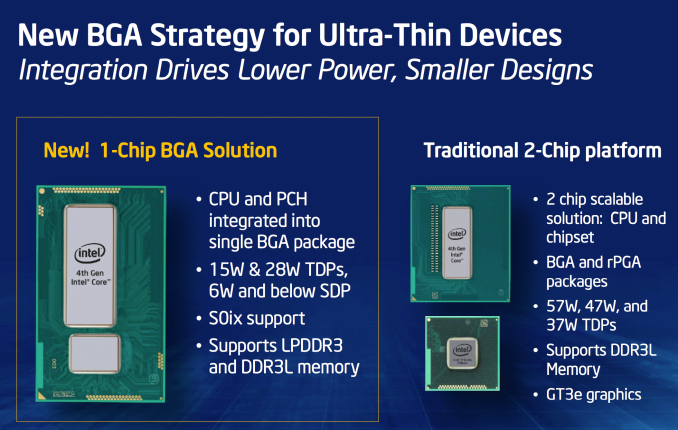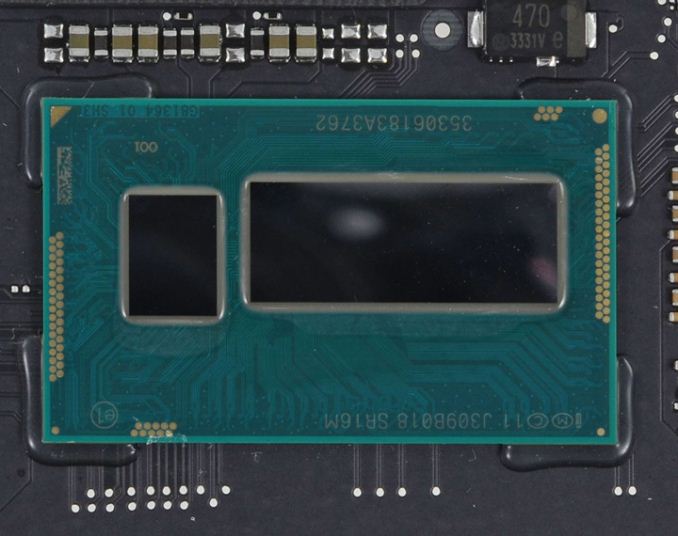The 2013 MacBook Air Review (13-inch)
by Anand Lal Shimpi on June 24, 2013 12:01 AM ESTThe CPUs
Apple keeps things simple across the 2013 MacBook Air lineup by configuring both 11 and 13-inch models with the same base CPU: a Core i5-4250U.
To understand Apple’s CPU choice, you have to understand that Apple is primarily concerned about improving battery life this generation. The line between MacBook Air and MacBook Pro has to be well defined. The Air is about portability, while the Pro is about performance. When faced with a power/performance tradeoff, it’s clear on which side of the fence Apple will fall whenever the MacBook Air is concerned.
| Apple 2013 MacBook Air CPU Comparison | |||||
| 1.3GHz dual-core | 1.7GHz dual-core | ||||
| Standard On | 11 & 13-inch MBA | Optional on Both | |||
| Intel Model | Core i5-4250U | Core i7-4650U | |||
| Base Clock Speed | 1.3GHz | 1.7GHz | |||
| Max SC Turbo | 2.6GHz | 3.3GHz | |||
| Max DC Turbo | 2.3GHz | 2.9GHz | |||
| L3 Cache | 3MB | 4MB | |||
| TSX-NI | No | Yes | |||
| TXT | No | Yes | |||
| AES-NI | Yes | Yes | |||
| VT-x/VT-x EPT | Yes | Yes | |||
| VT-d | Yes | Yes | |||
| TDP | 15W | 15W | |||
| Processor Graphics | Intel HD 5000 | Intel HD 5000 | |||
| GPU Clock (Base/Max) | 200/1000MHz | 200/1100MHz | |||
The lower base clock alone shouldn’t mean much, but the max TDP of the CPUs in the new MacBook Air falls as well - from 17W down to 15W. The thermal limit is even more dramatic since with Haswell ULT, the 15W includes the CPU/GPU as well as the on-package PCH. In Ivy Bridge the PCH was off package and wasn’t included in the 17W TDP.
Max turbo clocks are identical between the Haswell ULT CPUs Apple picked this round and the Ivy Bridge models before, but with a lower TDP it’ll be harder to always sustain the same frequencies given the right workload.
Haswell does feature a not insignificant gain in IPC compared to Ivy Bridge, which should help offset the power constraints that could otherwise force a larger regression in performance.
Both 2013 MBAs ship with the same CPU by default, and both can be upgraded to the same higher end SKU: a Core i7-4650U. The 4650U retains the same 15W TDP as the i5-4250U, but it increases its base clock speed to 1.7GHz and max turbo to 3.3GHz. The L3 cache also grows from 3MB to 4MB. All in all, this should be a very healthy upgrade in performance. Intel likely maintains the same TDP by binning for power; the i7-4650U is probably capable of running at higher frequencies without any appreciable increase in voltage. The max GPU clock also goes up by 10%.
Haswell ULT, Courtesy iFixit
What's arguably coolest about the i7-4650U is it enables Haswell's Transactional Synchronization Extensions (TSX-NI), a feature which is unfortunately disabled on the i5-4250U. I don't suspect this will matter much for most MBA users, but anyone looking to play around with Haswell's TSX instructions will want to opt for the higher end SKU. The upgrade costs $150 regardless of base model. Intel charges $454 for the i7-4650U and $342 for the i5-4250U, a difference of $112; Apple is adding another $38 onto the 1KU pricing, which isn't unreasonable.
Many have asked me what the impact of the i7 will be on battery life. I'm hoping to get my hands on an i7 based machine when I return from the UK in a week, but for those of you making immediate decisions I'll offer the following. Sustained operation at higher frequencies will likely draw more power, and negatively impact battery life. Light to medium workloads will enjoy a mix of race to sleep benefits as well as higher power consumption under load. Idle power should be roughly similar between the parts however. For most workloads I'd expect a modest impact to battery life, but it won't be enough to regress to 2012 levels of battery life. All of this is said without knowing key details like operating voltage for most 4650Us. I plan on addressing that shortly.












233 Comments
View All Comments
Gamingphreek - Monday, June 24, 2013 - link
Anand (or anyone else) -- I'm curious as to the effects of using Bootcamp. Doesn't bootcamp bootstrap the system into a legacy BIOS and create a fake-ish MBR? As such, aren't AHCI, EFI, and other new technologies presented in a legacy mode?For instance, on my mid-2010 MBP, I know that in bootcamp I do not have switchable graphics support and also do not have AHCI storage support.
Any comments on this functionality/limitation would be appreciated.
A5 - Monday, June 24, 2013 - link
I've never seen a $500 Ultrabook that wasn't a clearance of last year's chips. Also, the 13" is only $100 more, and the prices are pretty good for an ultraportable.Paapaa125 - Monday, June 24, 2013 - link
Show me a 1,3kg 13" Ultrabook with even a decent touchpad, 128SSD, i5 Haswell, 12h battery life for less than MBA 13" now sells. Really, it is not very expensive considering the HW you get! Not to mention great OS.Shadowmaster625 - Monday, June 24, 2013 - link
So it has Air in its name but it weighs more than 1 liter of water? Makes sense....Sm0kes - Monday, June 24, 2013 - link
Huh? I suspect marketing and branding is lost on you.Sushisamurai - Tuesday, June 25, 2013 - link
He has a point, with the new osX mavericks, a better name would be "MacBook water"seapeople - Tuesday, June 25, 2013 - link
It's actually specifically specced to equal the weight of compressed air at 3500ksi. Feel silly now? Leave the marketing to us engineers.tipoo - Monday, June 24, 2013 - link
It's been a long time since OSX vs Windows native gaming performance has been visited, I'd like to see that updated since there have been almost three OS releases since then and a small but significant influx of native games.ctwise - Monday, June 24, 2013 - link
It'll have to wait for OS/X Mavericks. That moves from OpenGL 3.x to OpenGL 4.x and, reportedly, improves performance significantly for even OpenGL 3.x clients (http://rk.md/2013/opengl-osx-mountain-lion-vs-mave...Krysto - Monday, June 24, 2013 - link
Holy cow. The Haswell chips in Airs have dropped to 1.3 Ghz now? Yikes. Before we know it Intel will claim 2W TDP for Core chips (but pay no attention to the 200 Mhz clock speed!)